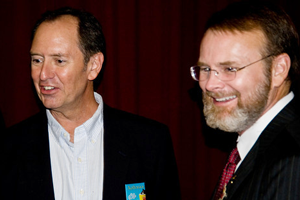Arnold School celebrates its past and looks ahead to growth, with a new building planned for the future
October 27 2010

Norman Arnold, speaking at the Arnold School’s 35th
Anniversary Celebration Luncheon, pledged money
toward a new building for the school.

Dean Tom Chandler and actor
Carl McIntyre are shown at the showing
of the film Aphasia.
The Arnold School of Public Health marked its 35th Anniversary on Oct. 22 – honoring a long tradition of growth and academic excellence and accepting a future challenge to unite all of its operations within one city block.
“It’s been a wonderful day for the Arnold School,” said Dr. Tom Chandler, Arnold School dean, at the end of a heady round of ceremonies.
Among the highlights:
The school will soon move an additional 30 percent of its operations into the Discovery One building behind the Koger Center. Chandler told a midday luncheon at the Russell House that USC officials had cleared him to begin raising funds for a third building in the same area to house the entire school, now scattered in a dozen locations around Columbia.
Chandler was closing his remarks for the anniversary dinner, when Norman Arnold, the school’s benefactor and namesake, announced that he would kick-off the fund-raising effort with a $10,000 gift. Arnold, who earlier told the group that his $10 million endowment to the school in 2000 was the best money he’d ever spent, was heartily applauded for this latest gift of generosity.
Accompanied by his wife, Gerry Sue, Arnold also was serenaded with a “Happy Birthday” rendition followed by the serving of a chocolate cake. Flashing red Cocky lapel pins presented to the gathering added a festive note.
During the dinner, Chandler said that the school had risen from humble beginnings in 1975, with only half a dozen faculty members, a $500,000 budget and some 30 students.
“Today, we have more than 100 faculty, an annual budget of $16 million and grants receipts of more than $55 million the past two years. We have a record enrollment of 1,609 students this year and our faculty publishes more than 300 peer-reviewed papers each year on all aspects of public health, he said.
The celebratory luncheon also highlighted the 20th anniversary of the affiliation of the Department of Exercise Science with the Arnold School, an exceptional arrangement among schools of public health in the United States. The Arnold School was the nation’s first school of public health to establish a department of exercise science as an academic units. Even today, only three schools of public health have such programs.
The Winona B. Vernberg Distinguished Lecture, named in honor of the founding dean of the Arnold School, was the emotional highlight of the day. Arnold School researcher Dr. Julius Fridriksson, an associate professor in the Department of Communication Sciences and Disorders, reviewed his research on aphasia and stroke.
Fridriksson said his studies reveal that brain functions controlled by cells that are killed by a stroke can be assumed by other neighboring cells. His research has been widely hailed by other experts and the popular media since it was published in the Sept. 15 issue of the “Journal of Neuroscience.”
Fridriksson underscored his presentation by showing the short film “Aphasia,” starring Charlotte actor Carl McIntyre who lost his speech and coordination from a 2005 stroke. A rapt Russell House audience looked on as the movie chronicled McIntyre’s continuing fight to recover from the stroke.
In a Q&A session afterward, McIntyre noted that “Aphasia s---ks! but added he was extending his recovery every day. The actor still struggles, speaking in sentences that resemble telegraph messages, but he is keeping a busy schedule of film and personal appearances in support of the movie and the cause of stroke recovery.
After McIntyre’s brief remarks, he was crowded by well-wishers, including other people with aphasia from the Midlands, at the front of the auditorium. Norman Arnold, a survivor of pancreatic cancer, was among the group. “You’re one of the most courageous men I’ve ever known,” he said before embracing the actor.
Faculty researchers have received nearly $21 million in grants since July 1, including one for $3.25 million that will enhance education and training for the state’s public-health workforce. Other funding will address minority health disparities for cancer victims and women, childhood obesity, lung health among victims of the Graniteville chlorine spill, drug resistant infection control and a home-based physical activity for persons living with HIV/AIDS. The latest funding follows two record years of grants for the school totaling more than $50 million.
Chandler said among the more important grants is a $3.25 million award to Drs. Greg Hand and Lillian Smith to establish the S.C. Public Health Training Center, which will develop infrastructure for public-health workforce development and ensure equal access to training resources for rural, underserved populations.
The dean said that by 2020, the Association of Schools of Public Health projects the nation will have a shortage of more than 250,000 public-health workers, including public-health physicians, educators, epidemiologists, environmental specialists, administrators and nurses.
Others receiving grant awards are:
- Dr. Saundra Glover, who has received a $6.7 million grant from the National Center on Minority Health and Health Disparities of the National Institutes of Health to support an established research program in minority health disparities. It will fund a Center of Excellence in the Social Promotion of Health Equity Research, Education and Community Engagement and will continue the Arnold School’s partnership with Claflin University in Orangeburg.
- Dr. James Hébert, head of the S.C. Cancer Disparities Network, who will use a $4.3 million National Cancer Institute grant to build upon the network’s many successes in cancer-disparities research, intervention and outreach programs, which are aimed at reducing cancer rates among African Americans in South Carolina.
- Dr. Erik Svendsen, who will use a $2.9 million NIH grant for a five-year study of the lung health of millworkers and community members who were affected by the chlorine-gas spill in Graniteville in 2005. Svendsen said victims in the Aiken County community continue to tell healthcare professionals that “we are still sick.”
- Drs. Alan Decho and Brian Benicewicz, who have received a $500,000 National Science Foundation grant to study on how engineered nanoparticles can be used more effectively to deliver antibiotics to cells. The study will target bacterial infections that have become resistant to traditional antibiotic therapies.
- Two additional grants totaling $349,000 will support minority health disparities in women. Drs. Jihong Liu and Sara Wilcox have received $181,000 from NIH for a study on healthy weight for pregnant African-American women. A grant of $168,000 to Dr. Myriam Torres from the Centers for Disease Control will support HIV/AIDS prevention among Latinas.
- Dr. Russ Pate of the Department of Exercise Science will collaborate with researchers throughout the Unites States on a $1.4 million NIH grant to study successful community programs aimed at reducing childhood obesity.
- A grant of nearly $500,000 from the Robert Wood Johnson Foundation – matched with funds from community partners in Richland and Lexington counties – will establish the Puentes Project to improve the health of Latinos. Drs. Deborah Billings and Julie Smithwick-Leone will lead the study.
- Drs. Greg Hand and Steve Blair will use a $407,000 NIH grant to develop a home-based physical-activity program to reduce the risk of heart disease and diabetes in people living with HIV/AIDS.



_01.jpg)
_02.jpg)